
The bearded barbet is an African barbet. Barbets are birds with a worldwide tropical distribution, although New World and Old World barbets are placed in different families. The barbets get their name from the bristles which fringe their heavy bills.

The green wood hoopoe is a large, up to 44 cm (17 in) long tropical bird native to Africa. It is a member of the family Phoeniculidae, the wood hoopoes, and was formerly known as the red-billed wood hoopoe.
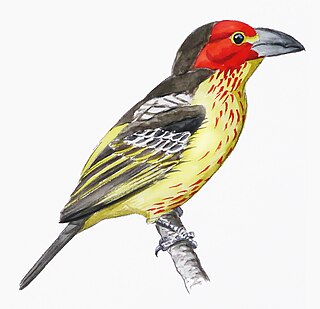
Vieillot's barbet is a small bird in the family Lybiidae. Barbets and toucans are a group of near passerine birds with a world-wide tropical distribution. The barbets get their name from the bristles which fringe their heavy bills. This bird is named after the French ornithologist Louis Pierre Vieillot.
Zakouma National Park is a 1,158-square-mile (3,000 km2) national park in southeastern Chad, straddling the border of Guéra Region and Salamat Region. Zakouma is the nation's oldest national park, declared a national park in 1963 by presidential decree, giving it the highest form of protection available under the nation's laws. It has been managed by the nonprofit conservation organization African Parks since 2010 in partnership with Chad's government.

The red-fronted gazelle is widely but unevenly distributed gazelle across the middle of Africa from Senegal to northeastern Ethiopia. It is mainly resident in the Sahel zone, a narrow cross-Africa band south of the Sahara, where it prefers arid grasslands, wooded savannas and shrubby steppes.
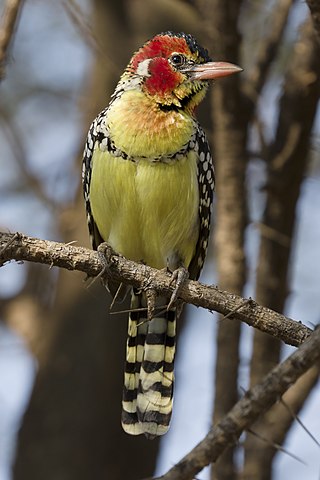
The red-and-yellow barbet is a species of African barbet found in eastern Africa. Males have distinctive black, red, and yellow plumage; females and juveniles are similar, but less brightly colored. The species lives in broken terrain and nests and roosts in burrows. Omnivorous, the species feeds on seeds, fruit, and invertebrates. Where not hunted, they are tame, but their feathers are used by certain tribes, such as the Maasai.

The wildlife of Chad is composed of its flora and fauna. Bush elephants, West African lions, buffalo, hippopotamuses, Kordofan giraffes, antelopes, African leopards, cheetahs, hyenas, and many species of snakes are found there, although most large carnivore populations have been drastically reduced since the early 20th century. Elephant poaching, particularly in the south of the country in areas such as Zakouma National Park, is a severe problem.
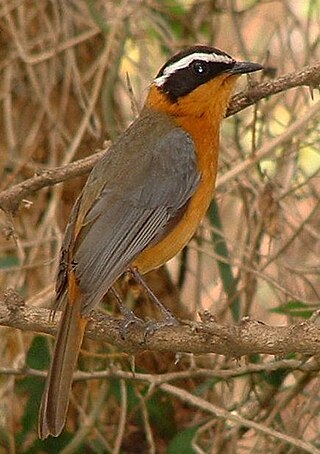
The white-browed robin-chat, also known as Heuglin's robin, is a species of bird in the family Muscicapidae. Found in east, central and southern Africa, its natural habitats include riverine forest and thickets, and it is also found near humans. The IUCN classifies it as a least-concern species.

Lybius is a genus of African barbets from the family Lybiidae. This genus ranges across sub-Saharan Africa.

The lesser honeyguide is a species of bird in the family Indicatoridae.

The double-toothed barbet is a species of bird in the family Lybiidae. It is found in Angola, Benin, Burundi, Cameroon, Central African Republic, Republic of the Congo, Democratic Republic of the Congo, Ivory Coast, Equatorial Guinea, Ethiopia, Gabon, Ghana, Guinea, Guinea-Bissau, Kenya, Liberia, Mali, Nigeria, Rwanda, Sierra Leone, South Sudan, Tanzania, Togo, and Uganda. Within Lybius bidentatus, there are two subspecies: Lybius bidentatus bidentatus and Lybius bidentatus aequatorialis.
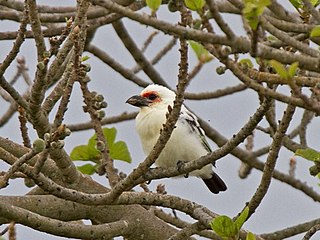
Chaplin's barbet or the Zambian barbet, is a bird species in the family Lybiidae, which was until recently united with the other barbets in the Capitonidae. This bird was named in honor of Sir Francis Drummond Percy Chaplin, a former colonial governor. The species was renamed to emphasize its status as Zambia's only true endemic bird species. It is endemic to South Central Zambia and is restricted to the area between the Upper Kafue River to Kabanga in the Kalomo District. Its natural habitats are moist savanna and arable land. It is threatened by habitat loss. It was formerly classified as a Near Threatened species by the IUCN. But new research has shown it to be rarer than it was believed. Consequently, it is uplisted to Vulnerable status in 2008.

The black-billed barbet is a species of bird in the Lybiidae family.

The white-headed barbet is a species of bird in the family Lybiidae. It is found in Angola, Cameroon, Central African Republic, Chad, Democratic Republic of the Congo, Kenya, Nigeria, South Sudan, Tanzania, and Uganda.
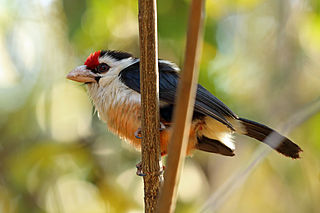
The white-faced barbet or black-backed barbet is a species of bird in the Lybiidae family. It is found in Gabon, Angola, Zambia, Republic of the Congo and Democratic Republic of the Congo. The habitat it is normally found in is riverine woodland and forest edges.

The red-faced barbet is a species of bird in the African barbet family Lybiidae. It is found in Burundi, Rwanda, Northwest Tanzania, and Southwest Uganda. Its natural habitats are dry savanna, moist savanna, and arable land. It is threatened by habitat loss.

The black-collared barbet is a species of bird in the family Lybiidae which is native to sub-Saharan Africa. Indigenous names include Rooikophoutkapper in Afrikaans, isiKhulukhulu and isiQonQotho in Zulu, and Isinagogo in Xhosa.

The banded barbet is a species of bird in the family Lybiidae. It is found in Eritrea and Ethiopia.
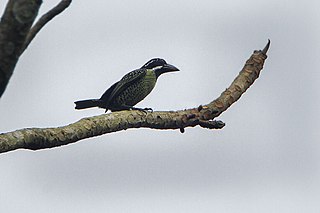
The hairy-breasted barbet is a species of bird in the family Lybiidae. It is found throughout the Africa tropical rainforest.

The black bishop is a species of passerine bird in the family Ploceidae native to Africa south of the Sahara. Three subspecies are recognised.




















